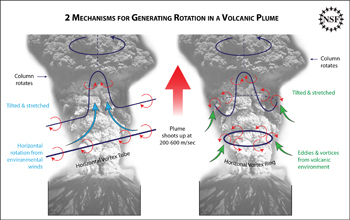Multimedia Gallery
Two mechanisms for generating rotation in a volcanic plume.
Two mechanisms for generating rotation in a volcanic plume have been shown. As the plume shoots up at an astounding 200 to 600 meters a second--winds from the environment surrounding the volcano can come into the picture as a horizontal vortex tube that is tilted and stretched as it travels up. This mechanism is similar to what is seen in thunderstorms. Additionally, eddies and vortices from the volcanic environment itself can form creating a horizontal vortex ring. This is what causes the lumpy-looking profile of the plume.
Credit: Zina Deretsky, National Science Foundation, after Chakraborty et al., Volcanic mesocyclones, Nature, 3/26/09
Images credited to the National Science Foundation, a federal agency, are in the public domain. The images were created by employees of the United States Government as part of their official duties or prepared by contractors as "works for hire" for NSF. You may freely use NSF-credited images and, at your discretion, credit NSF with a "Courtesy: National Science Foundation" notation.
Additional information about general usage can be found in Conditions.
Also Available:
Download the high-resolution JPG version of the image. (478 KB)
Use your mouse to right-click (Mac users may need to Ctrl-click) the link above and choose the option that will save the file or target to your computer.
Related story: Tornado-like Rotation Is Key to Understanding Volcanic Plumes



